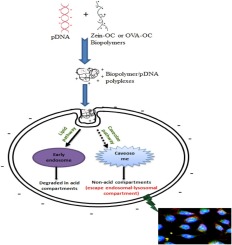Carbohydrate Polymers ( IF 11.2 ) Pub Date : 2018-08-31 , DOI: 10.1016/j.carbpol.2018.08.131 Monika Kumari , Chi-Hsien Liu , Wei-Chi Wu

|
Oligochitosan-modified proteins have gained attention as efficient non-viral vectors for gene delivery. However, little information exists if protein moieties can serve as an important role for internalization and endosome escape ability of the genetic material. To explore this issue, we designed two cationic oligochitosan-modified vectors that consist of different proteins, namely a hydrophobic plant protein (zein) and a hydrophilic animal protein (ovalbumin (OVA)) to deliver pDNA to epithelial cell line CHO-K1 and HEK 293 T. These cationic vectors were systematically characterized by molecular weight, infrared (IR) structural analysis, transmission electron microscopy (TEM) morphology, and surface charge. A remarkable impact of protein moieties was observed on physiochemical properties of the developed vectors. Oligochitosan-modified zein containing hydrophobic protein exhibited high buffering capacity and excellent DNA binding ability compared to the oligochitosan-modified OVA. The data on transfection in the presence of endocytic inhibitors indicated that the caveolae-mediated pathway (CvME) played a key role in the internalization of the zein-based polyplex. However, the OVA-based polyplex was internalized in CHO-K1 cells via CvME and in HEK 293 T cells via the lipid-mediated pathway. Moreover, oligochitosan-modified zein exhibited lower cytotoxicity, greater lysosomal escape ability, better plasmid stability, and better transfection efficiency than the oligochitosan-modified OVA. This study offers a facile procedure for the synthesis of cationic vectors and elucidates the relationship that exists between protein moieties and transfection activity, thus providing an alternative, non-viral platform for the gene delivery.
中文翻译:

寡壳聚糖修饰载体中的蛋白质部分调节内在化机制和基因传递:多态性表征,细胞内运输和转染
寡聚壳聚糖修饰的蛋白质作为有效的非病毒载体用于基因传递已引起关注。但是,如果蛋白质部分可以作为遗传物质的内在化和内体逃逸能力的重要角色,则几乎没有信息。为了探讨这个问题,我们设计了两种阳离子寡聚壳聚糖修饰的载体,它们由不同的蛋白质组成,即疏水性植物蛋白(玉米醇溶蛋白)和亲水性动物蛋白(卵清蛋白(OVA)),以将pDNA传递至上皮细胞系CHO-K1和HEK 293T。通过分子量,红外(IR)结构分析,透射电子显微镜(TEM)形态和表面电荷对这些阳离子载体进行了系统表征。观察到蛋白质部分对所开发载体的理化性质的显着影响。与寡壳聚糖修饰的OVA相比,寡聚壳聚糖修饰的包含疏水蛋白的玉米醇溶蛋白显示出高缓冲能力和优异的DNA结合能力。在存在内吞抑制剂的情况下转染的数据表明,小窝介导的途径(CvME)在基于玉米醇溶蛋白的多聚体的内在化过程中起着关键作用。但是,基于OVA的复合物通过CvME被内化到CHO-K1细胞中,并通过脂质介导的途径被内化到HEK 293 T细胞中。此外,与低聚壳聚糖修饰的OVA相比,低聚壳聚糖修饰的玉米醇溶蛋白显示出更低的细胞毒性,更大的溶酶体逃逸能力,更好的质粒稳定性和更好的转染效率。这项研究为阳离子载体的合成提供了简便的方法,并阐明了蛋白质部分与转染活性之间存在的关系,


























 京公网安备 11010802027423号
京公网安备 11010802027423号